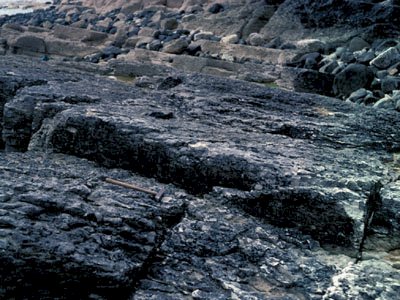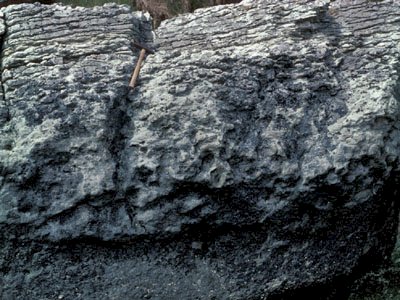Earth Science Conservation Review
| Cloghfin Port, Island Magee | Antrim |
| Site Type: | Coastal section |
| Site Status: | ASSI |
| Council area: | Larne Borough Council |
| Grid Reference: | J484942 |
| Google maps: | 54.77419,-5.69382 |
| Rocks | |
|---|---|
| Rock Age: | Cretaceous, Triassic (Campanian, Cenomanian, Coniacian, Rhaetian, Santonian, Scythian) |
| Rock Name: | Ballintoy Chalk Member, Belfast Marls Member, Boheeshane Chalk Member, Cloghastucan Chalk Member, Cloghfin Sponge Beds Member, Collin Glen Formation, Creggan Chalk Member, Galboly Chalk Member, Glenarm Chalk Member, Hibernian Greensands Formation, Island |
| Rock Type: | Greensand, Limestone, Marl, Mudstone, Sand, Siltstone |
| Interest | |
| Fossil Groups: | Belemnite, Brachiopod, Coral, Sponge |
| Other interest: | Marine sediments |
Summary of site:
This site is important for the long range of Mesozoic rocks present on the foreshore. Although the relationships are difficult to see in places, due to the isolation of the outcrops, faulting and possibly landslip, a great variety of rocks can be seen in a confined area.
The locality also has a long history of investigation involving important personalities in the early development of Irish geology. The Cretaceous rocks were described by Tate, Hall and Hume in the nineteenth century and Gough described the microscopic foraminifera of the Hibernian Greensands in the early years of the twentieth century. Geological Survey of Northern Ireland staff and colleagues of the British Survey reviewed and revised the sequence in the last quarter of the twentieth century, particularly Hugh Ivimey-Cook who worked the Rhaetian and Tony Griffith and Harold Wilson who remapped the area and prepared the memoir for the sheet. In 1977 a fundamental and monumental piece of work by ? Fletcher, also of the Geological Survey of Northern Ireland, clarified the previously impenetrable stratigraphy of the Ulster White Limestone. Robin Reid of Queen's University Belfast made an exhaustive study of the sponge faunas of the Hibernian Greensands in this area between the 1950s and the early 1970s. Few localities in Northern Ireland have received this level of attention.
The earliest rocks seen are Triassic in age and are red-brown mudstones of the Mercia Mudstone Group, followed by its topmost subdivision, the Collin Glen Formation, represented by 2m of green to grey mudstones. The last stage of the Triassic is called the Rhaetian and is around 210 million years old. At Cloghfin Port both its divisions can be seen. The lower is the Westbury Formation, comprising about 5m of mudstones with diagnostic Rhaetian fossil bivalve molluscs near the top. The upper division is the Lilstock Formation, comprising almost 2m of reddish-brown marls with silt and calcareous mudstones, also with diagnostic bivalves.
In the normal course of events, Jurassic rocks should follow the Triassic but even the condensed Jurassic sequence present north of Larne, at Waterloo Cottages, is absent here.
The next rocks to appear are the Hibernian Greensands Formation, with a thickness of just over 10m. This is the earliest Cretaceous formation seen in Northern Ireland (though far from the earliest rocks of the period itself, which by then was half elapsed) and the time interval between the Rhaetian rocks and these is over 100 million years. The area would have been dry land for a large part of that time, coinciding with the climax of the Age of Dinosaurs but, sadly, contemporaneous land and fresh water deposits have never been found in Northern Ireland.
The Kilcoan Sands Member follows after another break in the sequence. It is 2.5m thick and consists of pale to dark green sands. Its rich fauna includes a number of fossils with limited time distribution, aiding the dating process. The lower part is rich in lamp shells (brachiopods) and also includes sea urchins. A band of easily recognised prismatic shell fragments of the bivalve, Inoceramus, follows and above them are more age diagnostic brachiopods. The fossils give a Coniacian to early Santonian date (about 86 million years ago). The entire Turonian between the Island Magee Siltstones and the Kilcoan Sands is missing at Cloghfin Port.
Another break in sequence follows, succeeded by the Cloghfin Sponge Beds, for which these outcrops form the type locality (stratotype). They are 1.25m thick and form the base of the Ulster White Limestone Formation. The chalk contains large amounts of glauconite grains (giving a green coloration), reducing towards the top; as the name implies, it is rich in fossil sponges, here preserved as pseudomorphs (retaining their shape but with the original material replaced, in this case by phosphates) of the originals. The beds have been subdivided using their sponge content. From the Sponge Beds, the Ulster White Limestone Formation is complete as far as the Glenarm Chalk - eight members in all. Above the Cloghfin Sponge Beds is the flintless Galboly Chalk (1.5m thick), followed by the Cloghastucan Chalk (around 2m thick), then in succession: the gritty Creggan Chalk (2.6m thick); the Boheeshane Chalk (over 10m thick) with traceable flint bands; the two divisions of the Larry Bane Chalk (totalling 5m thick); the Ballintoy Chalk (about 11m thick); and finally the Glenarm Chalk, truncated above by an ancient erosion surface (preserving only the first 3.3m). There are erosion surfaces between all members from the Galboly Chalk to the Larry Bane Chalk, providing clear evidence of the shallowness of the sea and the frequent emergence of the sea bed. The fossils these members contain give good dates, from the late Santonian (around 85 million years ago) to the middle Campanian (around 80 million years ago).
This heavily researched area is part of the historic legacy of the science of geology in Northern Ireland and the variety of Triassic and Cretaceous rocks (incorporating the type locality of the Cloghfin Sponge Beds Member) add significantly to its interest. It is also the best collecting locality for fossils of the Belfast Marls Member anywhere in Northern Ireland. It should be designated and preserved.
The locality also has a long history of investigation involving important personalities in the early development of Irish geology. The Cretaceous rocks were described by Tate, Hall and Hume in the nineteenth century and Gough described the microscopic foraminifera of the Hibernian Greensands in the early years of the twentieth century. Geological Survey of Northern Ireland staff and colleagues of the British Survey reviewed and revised the sequence in the last quarter of the twentieth century, particularly Hugh Ivimey-Cook who worked the Rhaetian and Tony Griffith and Harold Wilson who remapped the area and prepared the memoir for the sheet. In 1977 a fundamental and monumental piece of work by ? Fletcher, also of the Geological Survey of Northern Ireland, clarified the previously impenetrable stratigraphy of the Ulster White Limestone. Robin Reid of Queen's University Belfast made an exhaustive study of the sponge faunas of the Hibernian Greensands in this area between the 1950s and the early 1970s. Few localities in Northern Ireland have received this level of attention.
The earliest rocks seen are Triassic in age and are red-brown mudstones of the Mercia Mudstone Group, followed by its topmost subdivision, the Collin Glen Formation, represented by 2m of green to grey mudstones. The last stage of the Triassic is called the Rhaetian and is around 210 million years old. At Cloghfin Port both its divisions can be seen. The lower is the Westbury Formation, comprising about 5m of mudstones with diagnostic Rhaetian fossil bivalve molluscs near the top. The upper division is the Lilstock Formation, comprising almost 2m of reddish-brown marls with silt and calcareous mudstones, also with diagnostic bivalves.
In the normal course of events, Jurassic rocks should follow the Triassic but even the condensed Jurassic sequence present north of Larne, at Waterloo Cottages, is absent here.
The next rocks to appear are the Hibernian Greensands Formation, with a thickness of just over 10m. This is the earliest Cretaceous formation seen in Northern Ireland (though far from the earliest rocks of the period itself, which by then was half elapsed) and the time interval between the Rhaetian rocks and these is over 100 million years. The area would have been dry land for a large part of that time, coinciding with the climax of the Age of Dinosaurs but, sadly, contemporaneous land and fresh water deposits have never been found in Northern Ireland.
The Kilcoan Sands Member follows after another break in the sequence. It is 2.5m thick and consists of pale to dark green sands. Its rich fauna includes a number of fossils with limited time distribution, aiding the dating process. The lower part is rich in lamp shells (brachiopods) and also includes sea urchins. A band of easily recognised prismatic shell fragments of the bivalve, Inoceramus, follows and above them are more age diagnostic brachiopods. The fossils give a Coniacian to early Santonian date (about 86 million years ago). The entire Turonian between the Island Magee Siltstones and the Kilcoan Sands is missing at Cloghfin Port.
Another break in sequence follows, succeeded by the Cloghfin Sponge Beds, for which these outcrops form the type locality (stratotype). They are 1.25m thick and form the base of the Ulster White Limestone Formation. The chalk contains large amounts of glauconite grains (giving a green coloration), reducing towards the top; as the name implies, it is rich in fossil sponges, here preserved as pseudomorphs (retaining their shape but with the original material replaced, in this case by phosphates) of the originals. The beds have been subdivided using their sponge content. From the Sponge Beds, the Ulster White Limestone Formation is complete as far as the Glenarm Chalk - eight members in all. Above the Cloghfin Sponge Beds is the flintless Galboly Chalk (1.5m thick), followed by the Cloghastucan Chalk (around 2m thick), then in succession: the gritty Creggan Chalk (2.6m thick); the Boheeshane Chalk (over 10m thick) with traceable flint bands; the two divisions of the Larry Bane Chalk (totalling 5m thick); the Ballintoy Chalk (about 11m thick); and finally the Glenarm Chalk, truncated above by an ancient erosion surface (preserving only the first 3.3m). There are erosion surfaces between all members from the Galboly Chalk to the Larry Bane Chalk, providing clear evidence of the shallowness of the sea and the frequent emergence of the sea bed. The fossils these members contain give good dates, from the late Santonian (around 85 million years ago) to the middle Campanian (around 80 million years ago).
This heavily researched area is part of the historic legacy of the science of geology in Northern Ireland and the variety of Triassic and Cretaceous rocks (incorporating the type locality of the Cloghfin Sponge Beds Member) add significantly to its interest. It is also the best collecting locality for fossils of the Belfast Marls Member anywhere in Northern Ireland. It should be designated and preserved.
| Enlander, I., Dempster, M. & Doughty, P., 2025. Cloghfin Port, Island Magee, County Antrim, site summary. [In] Earth Science Conservation Review. https://www.habitas.org.uk/escr/summary.php?item=1198. Accessed on 2025-04-03 |
| Previous Site | Next Site |



